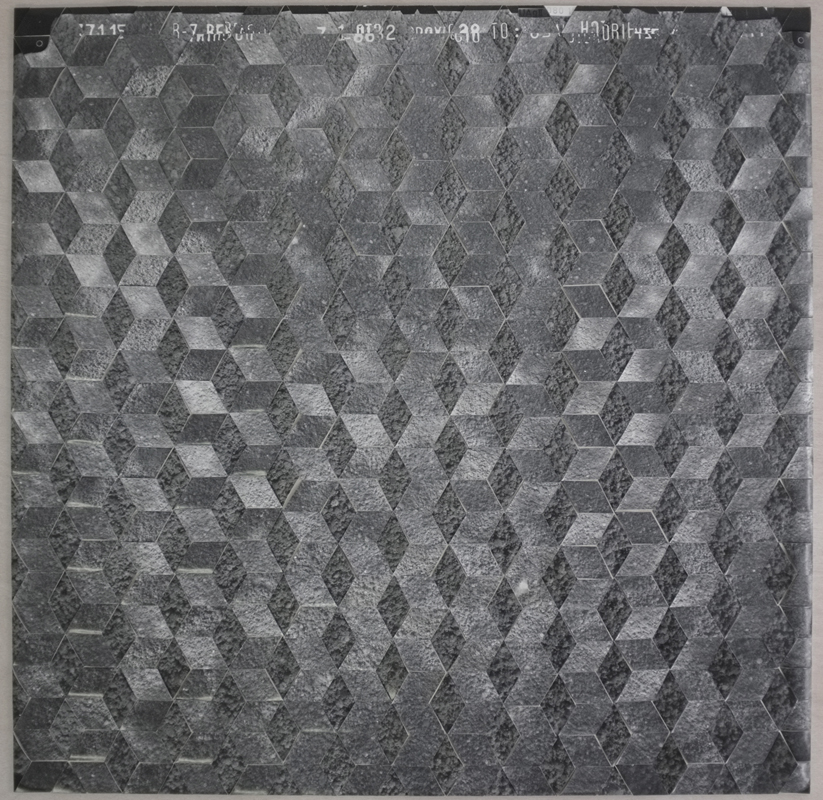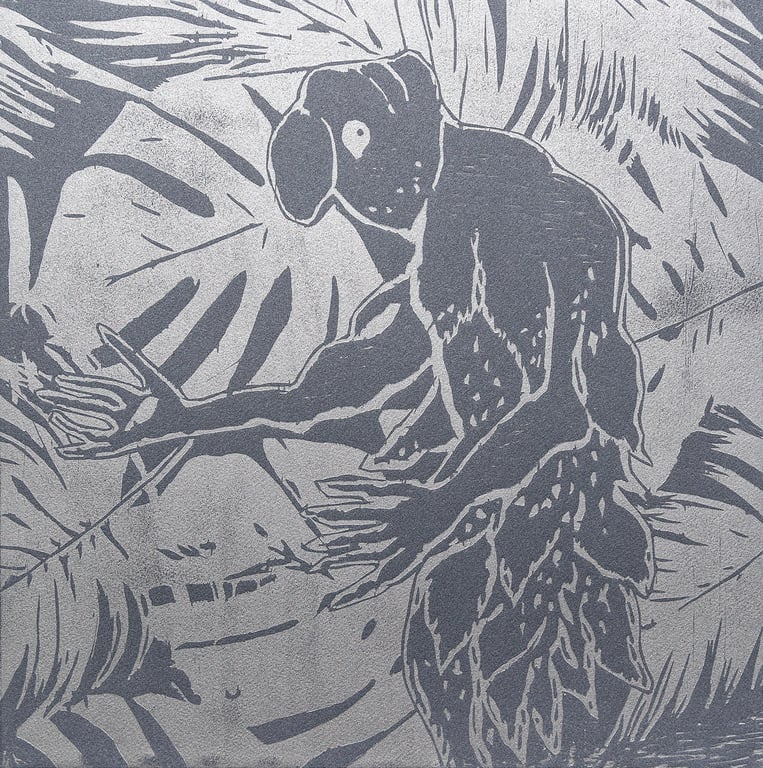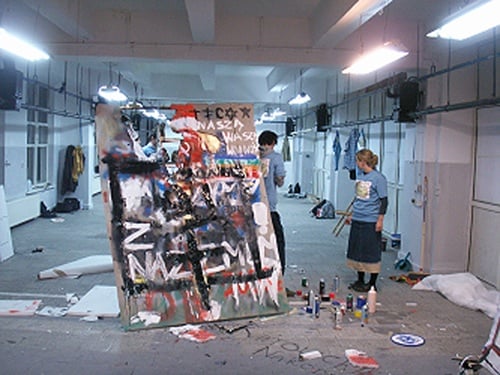
© » KADIST
Awol Erizku
Awol Erizku’s image Origin of Afro-Esotericism has compositional force and a rhythmic use of full-blast color. In the image are five faces each with varying modes of representation. One of them is “Aunt Jemima” (recently renamed Pearl Milling Company), a brand that appropriated a character from a late 19th century minstrel show.

© » KADIST
Ruth Patir
Historical representations of the female form and the clichés and misunderstandings that surround them have been the subject of recent research and historical revision. Marry, Fuck, Kill by Ruth Patir reimagines sculptures of fertility goddesses from ancient times as real-life women by animating them as a moving sculptural bodies. In a country such as Israel, where the presence of ancient ruins are common, if not everyday for some, this work speaks both to the present and the distant past, and draws continuities between.

© » KADIST
Jay Chung and Takeki Maeda
Jay Chung and Q Takeki Maeda remake a clip from the 1970s they found on the internet, and without really changing this archive material, displace it by imitating the staging and the acting with scrupulous precision. The slightest details are reproduced identically with great minutiae. The facial expressions are absurd, the prim attitude makes no sense.

© » KADIST
Rometti Costales
This anarchist flag is made from Huayruro seeds, a native plant of South and Central American tropical areas. In some cases, the Huayruro seeds are used in the preparation of psychotropic plants such as Ayahuasca (Tohé). These plants occupy a central place in Amazon biopolitics.

© » KADIST
Marguerite Humeau
This work forms part of a project that draws upon research into the use of psychoactive substances present in animal brains during the Paleolithic period. Bolstered by research by archaeologist Bethe Hagens, the artist explores the hypothesis that prehistoric shamans consumed the psychoactive parts of animal brains in order to achieve spiritual ecstasy and that the found figurines, reproduced by Marguerite Humeau, are an archival remnant of these experiences. The so-called “Venus figurines” take the form of ambiguous female forms and despite their exaggerated gendered traits, the onus is instead upon the resemblance to the ingested animal brains that led to their production.

© » KADIST
Newell Harry
(Untitled) Nimoa and Me: Kiriwina Notations by Newell Harry brings together a litany of contemporary politics—mobilization around enduring racism, the legacies of Indigenous and independence struggle, and the prospects of global solidarity against neocolonialism and social injustice. Yet what makes his stance unique is his idiosyncratic ‘anarchival’ method, developed over twenty years of living, working, and gathering in and around the South Pacific. From the resulting miscellany, Harry elicits thought-provoking new connections between collected artefacts; photographs and impressions authored by himself; and items drawn from journalist, activist, and documentary archives.

© » KADIST
Michael Linares
After two years of research in close conversation with anthropologists and archaeologists, Linares eventually enrolled in classes to study archeology—specifically the history of material artifacts. He became obsessed with the origin of metaphor, and the stick as the Ur (earliest) object used by humans that led to the formation of meaning itself. This video, which accompanies the “Museum of the Stick,” is part of major work surveying material culture collected and presented by the artist through a complex narrative of associations and anthropological research.

© » KADIST
Gala Porras-Kim
Drawing & Print (Drawing & Print)
The graphite drawing 4 mourners on a mantel by Gala Porras-Kim is part of a larger installation and body of research, entitled An Index and Its Settings (Un Índice y Sus Entornos) , in which the artist reconsiders 235 ancient burial figures (from circa 200 BCE – 50 CE) from what is now Mexico’s Pacific coast that are part of the Proctor Stafford Collection held by the Los Angeles County Museum of Art (LACMA). Eschewing their current musicological function, 4 mourners on a mantel presents photo-realistic depictions of said figures on top of a hypothetical collector’s fireplace. Herein, these funerary objects are displaced as curios which stare back at the viewer in signs of grief and confusion.

© » KADIST
Sergio Rojas Chaves
Más vale pájaro en mano que cien volando (A bird in the hand is worth more than two in the bush) is part of a larger series of pieces developed by Sergio Rojas Chaves in Honduras in 2018 that engages with tourism and in particular amateur-ornithologists that overrun the country in pursuit of the nation’s extreme diversity of bird species. The works include a performance in which artist Sergio Rojas Chaves, dressed like a bird, observes the ornithologists as if they too are birds, another work features an audio recording of amateur ornithologists imitating bird sounds in the jungle of Honduras. This series of photographs was taken during an amateur-ornithologist research trip.

© » KADIST
Matthew Angelo Harrison
In Hole #1 a zebra scull stands in as a representation of Africa, while the plexiglass box and the hole made through it represent the inaccessibility of that culture to African-Americans.

© » KADIST
Dale Harding
Dale Harding’s installation Body of Objects consists of eleven sculptural works that the artist based on imagery found at sandstone sites across Carnarvon Gorge in Central Queensland. Mouth-blown with ochre on sandstone, these extraordinary stencilled images depict weaponry, domestic tools, and ceremonial objects that are specific to the region and that relate to Harding’s own ancestry. In response to these enduring indexes of Indigenous material culture, Harding produced a suite of cast objects using the stencilled imagery as a guide, along with objects that relate to his family history: boomerangs, spears, clubs, and whips are all part of the display.

© » KADIST
Danh Vo
Good life (2007) is an installation displaying letters, documents, photographs and objects from a man named Joseph Carrier, and appropriated by artist Danh Vo. The installation features a series of small square vitrines, inset, dark and precisely spot-lit. Inside these are framed photographs, mostly black and white, of young Asian men, taken, as the titles on the neat brass name plates tell us, in Vietnam in the 1960s and early 1970s.

© » KADIST
Zai Kuning
Justice (2014) presents viewers with a curious assemblage: a wooden gallows with slightly curved spindles protruding from the topmost plank, which in turn is covered with rudimentary netting, the threads slackly dangling like a loose spider’s web or an rib cage that’s been cracked open. A bundle of small red rattan balls hang from the front end of the plank, precariously knotted to a single thread hanging from the gallows’ edge. A book hangs from similar red threads at the plank’s rear, its surfaced wrapped multiple times over with the thread to hold it in place, the red thread resembling blood vessels or connective tissue.

© » KADIST
Li Ran
The four-channel video installation Same Old Crowd departs from the documentation of an unknown city and takes place in an ambiguous temporal and spatial frame. Twelve characters (amateur actors hired by the artist) appear in black-and-white in highly stylized surroundings wearing patterned cloths. The identities or time period of the characters, all deprived of languages, are impossible to determine.

© » KADIST
Haegue Yang
A steel clothing rack adorned with turbine vents, Moroccan vintage jewelry, pinecones and knitting yarn, these heterogeneous elements are used here to create an exotic yet undefined identity within the work. Following Haegue Yang’s 2010 anthropomorphic series Medicine Men, this sculpture appears as a shamanic objet or being. It is mobile and can be activated.
Li Ran
- location: Beijing, China
- year born: 1986
- gender: male
- nationality: Chinese
- home town: Hubei Province, China
Marguerite Humeau
Marguerite Humeau’s work begins with intensive research that calls upon the expertise of various specialists including historians, anthropologists, paleontologists, zoologists, linguists or conspiracy theorists...
Rometti Costales
Rometti Costales is an artistic collaboration between Julia Rometti and Victor Costales that began in 2007...
Jay Chung and Takeki Maeda
Jay Chung and Takeki Maeda’s practice is characterized by performance, which often involves weighty unsettling humour...
Haegue Yang
- location: Berlin, Germany & Seoul, South Korea
- year born: 1971
- gender: female
- nationality: Korean
- home town: Seoul, South Korea
Awol Erizku
A contemporary response to the historical motif of the still-life, Awol Erizku’s studio photography is brimming with color and symbolism...
Danh Vo
- location: Berlin, Germany
- year born: 1975
- gender: male
- nationality: Vietnamese and Danish
- home town: Ba Ria, Vietnam
Michael Linares
Michael Linares (San Juan, Puerto Rico) asks critical questions about the most fundamental forms and concepts of art...
Dale Harding
A descendant of the Bidjara, Ghungalu, and Garingbal peoples, Dale Harding’s work references and expands upon the philosophical and spiritual touchstones of his cultural inheritance...
Newell Harry
Newell Harry’s practice traces an intimate web of connections and histories linking Pacific island cultures (especially those of the Vanuatu archipelago)–via Australia, where he lives, and the Malay world–to South Africa’s Western Cape Province, the home of his extended family...
Ruth Patir
Ruth Patir works with video and performances that complicate facile separations of public and private spheres...
Sergio Rojas Chaves
Sergio Rojas Chaves’s work focuses on contemporary depictions of animals and of plants and affective approaches to biology...
Zai Kuning
- year born: 1964
- gender: male
- nationality: Singaporean
- home town: Singapore
Matthew Angelo Harrison
Detroit’s Matthew Angelo Harrison works at the intersection of sculpture and technology, building his own 3D printers (which rise to the status of sculpture), and using these creations to formulate others...
Gala Porras-Kim
Gala Porras-Kim’s work plays objects against their framing to consider how an artefact’s “message” is tempered by display, use, historic setting, and other modes of exchange...
-
2000-2009
Jay Chung and Takeki Maeda
2009Jay Chung and Q Takeki Maeda remake a clip from the 1970s they found on the internet, and without really changing this archive material, displace it by imitating the staging and the acting with scrupulous precision...
-
2010-2019
Rometti Costales
2013This anarchist flag is made from Huayruro seeds, a native plant of South and Central American tropical areas...
Michael Linares
2014After two years of research in close conversation with anthropologists and archaeologists, Linares eventually enrolled in classes to study archeology—specifically the history of material artifacts...
Zai Kuning
2014Justice (2014) presents viewers with a curious assemblage: a wooden gallows with slightly curved spindles protruding from the topmost plank, which in turn is covered with rudimentary netting, the threads slackly dangling like a loose spider’s web or an rib cage that’s been cracked open...
Newell Harry
2015(Untitled) Nimoa and Me: Kiriwina Notations by Newell Harry brings together a litany of contemporary politics—mobilization around enduring racism, the legacies of Indigenous and independence struggle, and the prospects of global solidarity against neocolonialism and social injustice...
Matthew Angelo Harrison
2015In Hole #1 a zebra scull stands in as a representation of Africa, while the plexiglass box and the hole made through it represent the inaccessibility of that culture to African-Americans....
Haegue Yang
2016A steel clothing rack adorned with turbine vents, Moroccan vintage jewelry, pinecones and knitting yarn, these heterogeneous elements are used here to create an exotic yet undefined identity within the work...
Gala Porras-Kim
Drawing & Print
2017(Drawing & Print) The graphite drawing 4 mourners on a mantel by Gala Porras-Kim is part of a larger installation and body of research, entitled An Index and Its Settings (Un Índice y Sus Entornos) , in which the artist reconsiders 235 ancient burial figures (from circa 200 BCE – 50 CE) from what is now Mexico’s Pacific coast that are part of the Proctor Stafford Collection held by the Los Angeles County Museum of Art (LACMA)...
Awol Erizku
2018Awol Erizku’s image Origin of Afro-Esotericism has compositional force and a rhythmic use of full-blast color...
Marguerite Humeau
2018This work forms part of a project that draws upon research into the use of psychoactive substances present in animal brains during the Paleolithic period...
Sergio Rojas Chaves
2018Más vale pájaro en mano que cien volando (A bird in the hand is worth more than two in the bush) is part of a larger series of pieces developed by Sergio Rojas Chaves in Honduras in 2018 that engages with tourism and in particular amateur-ornithologists that overrun the country in pursuit of the nation’s extreme diversity of bird species...
Dale Harding
2018Dale Harding’s installation Body of Objects consists of eleven sculptural works that the artist based on imagery found at sandstone sites across Carnarvon Gorge in Central Queensland...
Ruth Patir
2019Historical representations of the female form and the clichés and misunderstandings that surround them have been the subject of recent research and historical revision...





















